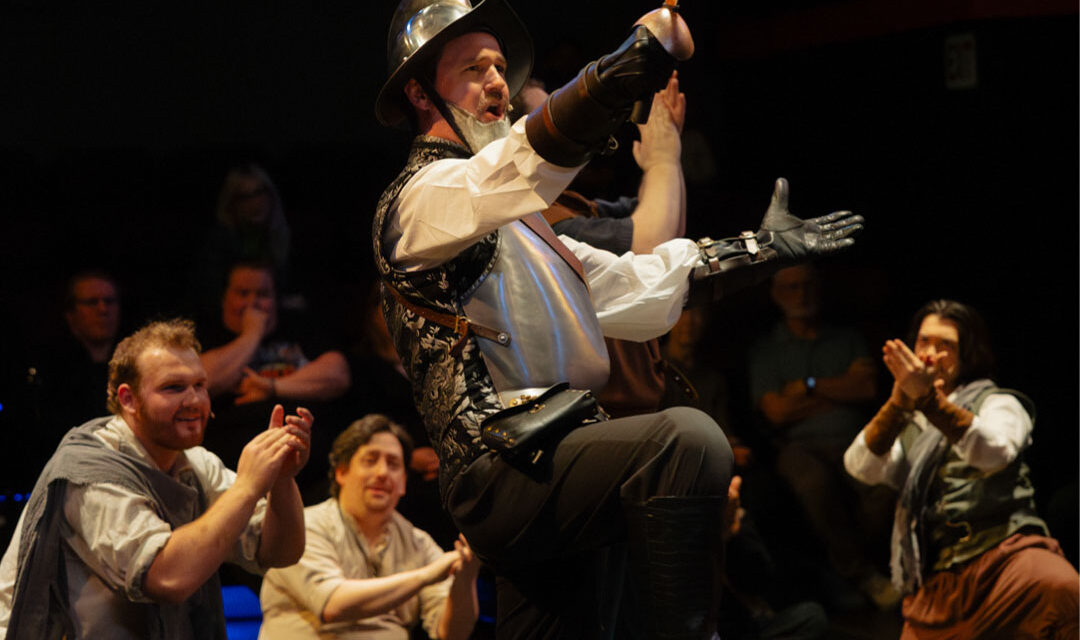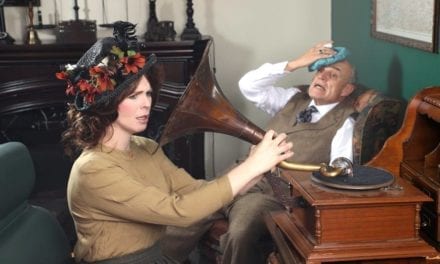ST. GEORGE — If falling into madness means the opportunity to witness the inspiring journey of Don Quixote in St. George Musical Theater’s recent production of Man of LaMancha, one should be sorely tempted to “set aside the burden of sanity” and revel in the beauty of this show.
Fortunately, setting aside one’s sanity is not required. But for anyone choosing not to take the opportunity to witness this transcendent production, their cognitive abilities might well be called into question.
Based on the work of Spanish author Miguel Cervantes, and adapted from the book by Dale Wasserman, Man of LaMancha is an unbelievably layered piece that captivates the audience with the simplicity of its play-within-a-play, while leaving the viewer pondering on the deeper meanings and implications behind its message long after the much-deserved standing ovation is over.
This iteration is tackled by Director Lawrence P. Vincent, along with musical direction by Paul Taylor. The printed program (hooray for any theater who provides printed programs, as they all should) alludes to a few bumps in the road for the cast and crew of this musical, namely the unexpected removal of the original director due to a serious illness, with Vincent stepping in partway through the process. With a warning like that, it would have been understandable if the show was not fully ready on opening weekend — but nothing could be further from the truth.
Polished. Strong. Immersive. Thought-provoking and riddled with talent. These are more apt descriptions of the evening as a whole.
The story opens as Miguel de Cervantes, a playwright and tax collector, is tossed into a prison dungeon to await trial by the Spanish inquisition. Cervantes is immediately surrounded by foes — his fellow prisoners — who hold a trial of their own in an effort to seize his belongings. Leaning into his work as a playwright, Cervantes offers his defense as a theatrical performance in which he becomes Alonso Quijana, an aging squire who imagines himself as a knight errant, Don Quixote, embarking on a noble quest with his servant Sancho.
Don’t worry. It is much easier to follow than it sounds.
In some cases, a play-within-a-play might make for a bit of confusion in keeping track of the characters as they step in and out of their micro roles. However, SGMT’s Man of LaMancha takes all the guesswork out of the process with a few simple props, and an arsenal of talented actors, making the transition from Cervantes to Quijana to Quixote seem almost effortless.
Much of the praise for those transitions, and the believability of each of those three roles, goes to the phenomenal performance by John Tanner. His portrayal of the addled yet loveable Don Quixote was truly a pleasure to behold. From the dulcet tones of “Dulcinea” to the majestic “Man of LaMancha,” and the rich rendition of the pinnacle, “Impossible Dream,” Tanner is clearly in his element in this space. But it was not his vocal prowess alone that commanded the audience’s attention. His acting range — from the physical comedy of climbing on and off his “horse,” to his emotional breakdown as the fantastical Quixote story is interrupted by the harsh reality of Cervantes’ dungeon life — showcased an actor who has something to offer in many realms.

Man of La Mancha plays at SGMT through April 19.
Filling a role that is every bit as important as the lead itself, it is impossible to overlook the powerful contribution made by Kramer Kwalick in the role of Sancho, the trusty sidekick and loyal follower of Don Quixote. Without the support of Sancho, none of Quixote’s antics would be understood, or believed, by the people around him, making Sancho a pivotal player in the unfolding of this multi-layered tale. Kwalick’s lithe, agile movements, quick wit, and excellent singing voice, give life to some of the lighter-hearted numbers like “The Missive, “I Really Like Him” and “A Little Gossip.” His interactions with Aldonza (played by Lauren Pratt) allow the audience to connect with these two characters in a way that is unique to the rest of the show.
Taking on the role of Aldonza in this viewing, Pratt demonstrates a tragic character that is both believable and heartbreaking to witness. Viewed by the world as one who is worth little, she is at first confused and uncomfortable by the praise and attention afforded her by Don Quixote. Her passion and fervor were almost palpable as she uncovered some of her backstory in the moving “Aldonza,” making her impassioned plea during “Dulcinea (reprise)” even more rewarding to see.
David Brinley’s portrayal of the Innkeeper/Governor is another performance worthy of note. He has a commanding presence on stage in general, while his musicality on “Knight of the Woeful Countenance” was particularly strong as he gives into Don Quixote’s plea to be properly knighted and named.
The entire cast deserves the highest praise, not only for helping the plot and subplots make so much sense, but for executing the story with such skill that it felt like a true ensemble effort. Each contributor showcased acting and vocal skills worthy of the leading roles, regardless of the size of their parts.
Take Nathan Benner, Rory Wagner, Thomas Murray and Gary Castillo, for example, who stepped in and out of roles including the Padre/Pedro, The Duke/Dr. Carrasco, Barber/Muleteer, and Captain of the Inquisition/Muleteer respectively. Each of their singing voices held beautifully true on songs like “Dulcinea” and “Little Bird, Little Bird,” while making the audience hate their barbarous actions in “The Abduction.”
Likewise, the strength of the ensemble was readily showcased on several numbers that highlighted three or four of the supporting roles, moving them momentarily to center stage. One example is the harmonizing skill displayed by Melanie Petersen (as Antonia), Alyssa Zerkle Reid (Housekeeper), Benner (Padre) and Wagner (Dr. Carrasco) in “We’re Only Thinking of Him.” Benner also had the distinction of setting the closing tone for the show with his hauntingly beautiful rendition of “The Psalm”.
None of the aforementioned musical praise could have been achieved in quite the same way had it not been for the addition of live musicians in an on-stage orchestra. Paul Taylor on piano, Brad Pike on guitar, Jarom Brown on flute, piccolo, oboe and trumpet, and Alyssa Reid and Rory Wagner on percussion, brought a depth to the production that simply cannot be achieved with pre-recorded sound. In the best way possible, the music melded into the story as a whole, making its absence in a couple of key moments on stage even more poignant; and its return all the more wonderful.
In terms of non-acting elements, this production errs on the simplistic side, which fits perfectly into the fact that much of the story is being told by prisoners in a dungeon — whose resources for costumes and props would likely be scarce. But that doesn’t make these components any less noteworthy. For example, Costume Designer Ester Taatarii and Props Master Emili Whitney should be proud of the design and execution of the two horses used by Don Quixote and Sancho. These large horse heads are a patchwork of various fabrics, many of which are translucent enough to allow the actors beneath to see where they are going. The result is something realistic enough to recognize as horses and abstract enough to fit with the imaginary storytelling happening on stage.
The bulk of the costumes changes are minimal; the donning of a hat or a scarf to denote the change of a character, small but effective alterations. None is truer in this sense than the basic beard Don Quixote puts on — a simple but extremely important prop.
Under Vincent’s careful direction, the audience is allowed to become so entrenched in the mythical Don Quixote storyline, when the dungeon guard suddenly arrives on the scene it creates a jarring juxtaposition between the imaginary world and the prisoners’ reality. But after a momentary breath of the less pleasant dungeon air, the cast and the audience are quickly allowed to escape once more into Cervantes’ story, but only momentarily, before the production reaches its emotional conclusion. It’s a journey well worth undertaking.





